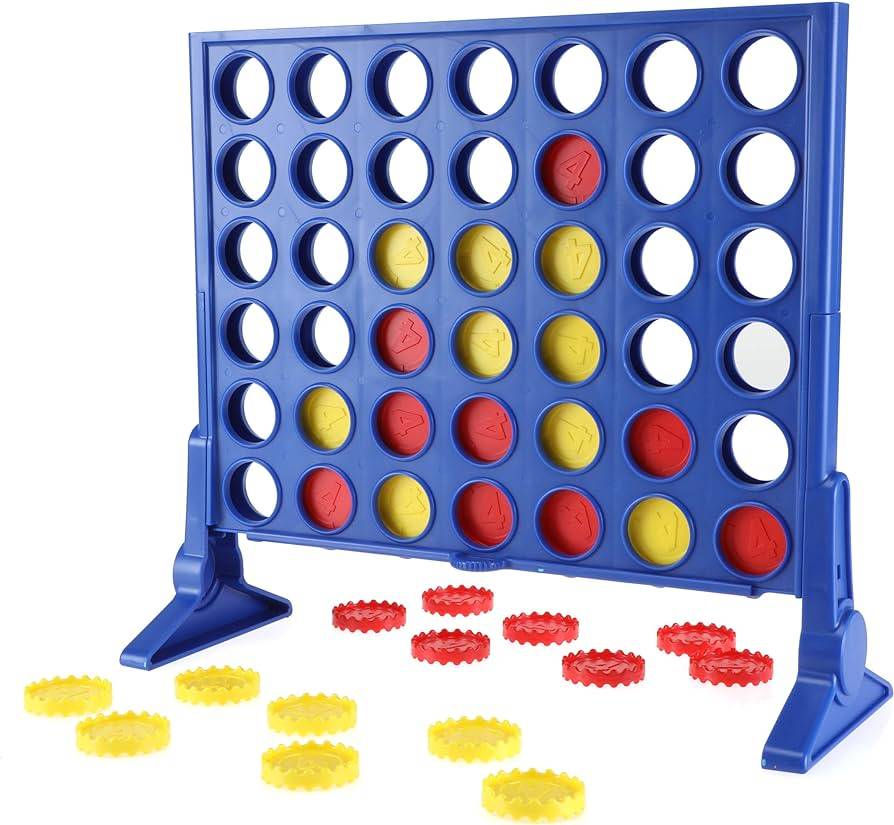- The basic elements of Connect Four are as follows:
- Actions: place a token of your color into one of seven columns.
- Goals: have four tokens of your color adjacent (including diagonally) on the board before your opponent.
- Rules: place one token at a time and alternate which player may place a token. If a column is full, no more tokens may be placed into that column.
- Objects: tokens (of two different colors)
- Playspace: A vertical board with seven columns and six rows such that, when a token is placed into any column, it falls to the bottom available space.
- Players: Two players working against each other.
- Imagine you applied the players of the card game Spades to Connect Four. In Spades, there two teams of two players each. By itself, this might only marginally change the game as it would just be playing connect four with a partner, so you might discuss strategy and would be less likely to make silly mistakes. However, imagine you also imported the mechanic in spades that teammates cannot directly communicate with one another and play every other turn. Usually in connect four you’re trying to set up traps without your opponent catching on, but in this game you’d want your partner to be on the same page as you without either of your opponents catching on, which seems like a much tougher challenge. Since you not only have to think about what your opponents are trying to do but also what your teammate is trying to do, this would turn connect four into more of a mind-reading game and may introduce avenues of strategy regarding which opponent to target if you think one of them might be less quick to pick up on clever moves.
- A very simple game I’d play with my dad when I was young is called Nim-21 (or count 21). Players take turns counting to 21 by adding 1, 2, or 3 to the previous number. The player forced to say 21 loses.

- Real-time game: Spikeball
- Team A has players 1 and 2 and team B has players 3 and 4.
- The game-states for a single point are as follows:
- Player 1 on team A serves to player 3 on team B
- Player 3 passes the ball to player 4 who hits the ball hard into the net
- Player 2, having anticipated a hard hit from player 3, is running back to get the ball. They hit the ball high in the air towards player 1.
- Player 1 hits the ball up between player 2 and the net as player 2 rushes back towards the net
- Player 2 acts as though they are going to slam the ball into the net, but instead lightly touches it
- Player 3 has moved back anticipating a slam, but the ball bounces lightly on the net and then onto the ground
- When I was initially writing the game states, I thought this might be classified as a turn-based game because each side takes turns possessing the ball while the other side doesn’t have anything to do according to the rules. However, when describing the game states in a more thorough manner, I realized that the players from both teams are always acting or reacting, resulting in continuous action from all players. This dynamic seems to emerge from any number of real time games where players have to be constantly anticipating what their opponents are about to do so they can respond in time.
- Turn based game: Tik Tak Toe
- There are two players–player X and player O
- The game states are as follows:
- Player X places an X in the top right corner
- Player O places an O in the bottom left corner
- Player X places an X in the top left corner
- Player O places an O in the top middle
- Player X places an X in the bottom right corner
- Player O places an O in the left middle
- Player X places an X in the middle and wins the game
- It’s immediately clear to me that the game-states in Tik-Tak-Toe are much simpler than the game states in Spikeball. Partly this is because Tik-Tak-Toe is a very simple game, but the main difference, I find, is that I could accurately and completely describe each game state for Tik-Tak-Toe whereas, for spikeball, it seems nearly impossible to accurately and completely characterize the game states. This is because every little micro-movement in spikeball might affect how other players will react and have a ripple effect completely transforming the round, whereas in Tik-Tak-Toe, that just doesn’t seem to be the case. In Tik-Tak-Toe, you can’t really pull the same kind of move that player 2 pulled off in spikeball where you pretend you are going to do one thing to catch the other player off-guard. It doesn’t matter where they hovered their pencil–once they make their mark, the other player can respond to just the board and completely disregard everything else.


